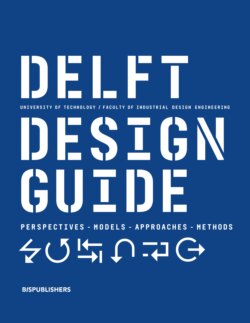Читать книгу Delft Design Guide -Revised edition - Annemiek van Boeijen - Страница 48
На сайте Литреса книга снята с продажи.
ОглавлениеStep 1 - Product use: The use of the company’s existing pro- ducts is seen as the starting point for the next innovation round. This stage involves connecting product use with the next step – which is referred to as a strategy formulation for the company – thereby initiating the next innovation cycle.
----------------
Step 2 - Strategy formulation: This stage starts with determining the current strategic situation of the company using an internal and external analysis of the company. By combining these two analyses, you can formulate search areas, which are strategic ideas for innovation and are potential new business opportunities. When evaluating these search areas you can check their validity in a number of ways such as expert interviews, looking at patents, or observing potential customers and users.
----------------
Step 3 - Design brief formulation: In this stage, the selec- ted search areas are transformed into product ideas, which
are then formulated in a design brief. This brief describes the ideas in a way that an internal or external design team can start developing the product or service. The brief can include a vision statement, a program of requirements, and other guidelines to steer the design direction.
----------------
Step 4 - Development: This stage involves traditional design activities that are related to product design, and such activities include creating a marketing plan and assessing the required technology for the product and its production. A number of essential components will result from this stage, such as working prototypes, technical documents and assembly schemes.
----------------
Step 5 - Market introduction: This stage entails the further development of a full-scale manufacturing process as well as marketing, encompassing sales, promotion, and distribution. The final result is the product launch.
Product Innovation Process
What & Why? A company often responds to changes inside and outside its organi- sation by developing new products. This kind of development can be seen with the Product Innovation Process, which is a model that describes innovation as a process of experiential learning in a continuous loop. Several stages are seen in this loop: the de- velopment can begin from people using an existing product, to the company forming its strategic product position, to the project undergoing stages of product development, and finally to the product launch where people are using the new product. The model can help you to organise and align all activities in this loop.
The Product Innovation Process model advances a stepwise approach to product design and development, and it is intended for active use by designers to set agendas and collaborate with others in innovation.
----------------------------------------------------------------------------------------------------------
Mindset: Broaden in your mind the position of design in innovation and make a departure from the tradition that describes design as a function to bridge a world of production with a world of consumption.
-----------------------------------------------------------------------------------------------------------
How? The process consists of five stages that are visually similar in terms of building blocks, shape, and size. Each stage ensures creativity in innovation by requiring divergent thinking and by forcing innovators to consider the company’s internal and external environment. For each step in the model, various methods are developed to support research and development, as well as other activities in the design process. For example, for the strategy formulation stage (Step 5), you can use methods such as Strategy Wheel and SWOT & Search Areas. In the development stage (Step 4), you can try several different approaches for creativity.
References & Further Reading Buijs, J. A., 2012. The Delft Innovation Method; a design thinker’s guide to innovation. The Hague: Eleven International Publishing. / Buijs, J. & Valkenburg, R., 2005. Integrale Productontwikkeling. 3rd ed. Utrecht: Lemma. / Buijs, J., 2003. Modelling Product Innovation Processes: from Linear Logic to Circular Chaos. Creativity and Innovation Management , June, 12(2), pp. 76-93 .
Tips & Concerns
The visualised innovation process, a circular model, suggests that there is neither a beginning nor an end. This is true because a new product on the market will lead to reactions from competitors. These reactions will eventually eat away the competitive advantage of the new product, and this would necessitate the start of a new Product Innovation Process.
-------------------------------------------
Limitations
In theory, the model could also be applied to the innovation of digital services in highly networked eco- systems. However, in those cases, you need to be aware that it is hard to make a distinction between the analyses (internal and external) and between the human factors (users and providers).
----------------
The model was not conceived for more agile forms of innovation, where ideas are quickly prototyped and marketed for faster learning cycles. In agile innovation, certain stages in the model can be skipped in order to speed up the innovation process.
The Product Innovation Process model describes the overall process of product innovation, along with an emphasis on the fuzzy front end. The model can help designers plan for and manage innovation as well as to keep an overview of the process while innovating.
---------------------------------------------------------------------------------------------------------------------------------------------------------------
---------------------------------------------------------------------------------------------------------------------------------------------------------------
MODELS
47
